- Joined
- Thursday August 27, 2015
The Gillette Aristocrat Junior is a largely overlooked razor. Misidentified and misunderstood, most wetshavers view it as nothing more than a Rocket in a fancy case. In fact, there was very little known about British Gillette razors until a few years ago. As late as 2007, these were often still referred to as 'Double Ring Rockets.'
These razors (well, most of them, anyway) are much more than that. There are six models of Aristocrat Juniors. Two of those models also have aluminum varients, and one of the six models is identical to a late model Rocket. Another one is identical to an American Super Speed. For the most part, they are English Aristocrat heads on thinner handles, and for the most part, they are nickel plated brass or anodized aluminium. A few gold varients exist, but those are very uncommon. Most seem to be aluminium models.
The 'first' Aristocrat Junior was an American razor, the first and last of it's kind. It was, for all intents and purposes, a 1947 Super Speed razor in an Aristocrat Junior labeled box. I'm including it merely for the sake of completeness. It's the only American Aristocrat Junior, and unless one also owned the case, would be identified as a common Super Speed.
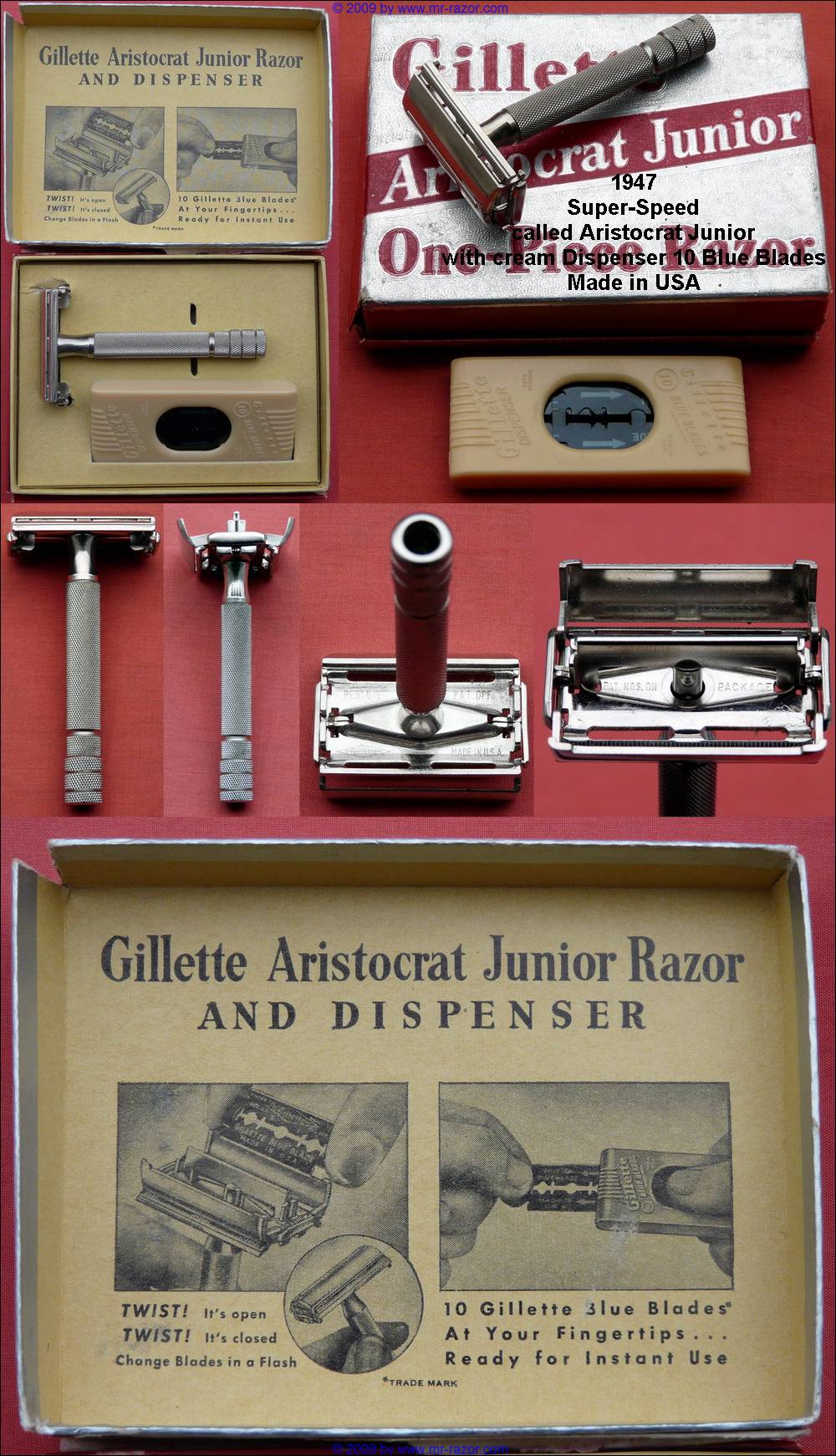
The first 'true' Aristocrat Junior was made in England from 1948-1949. It was called the No. 48 (#48).
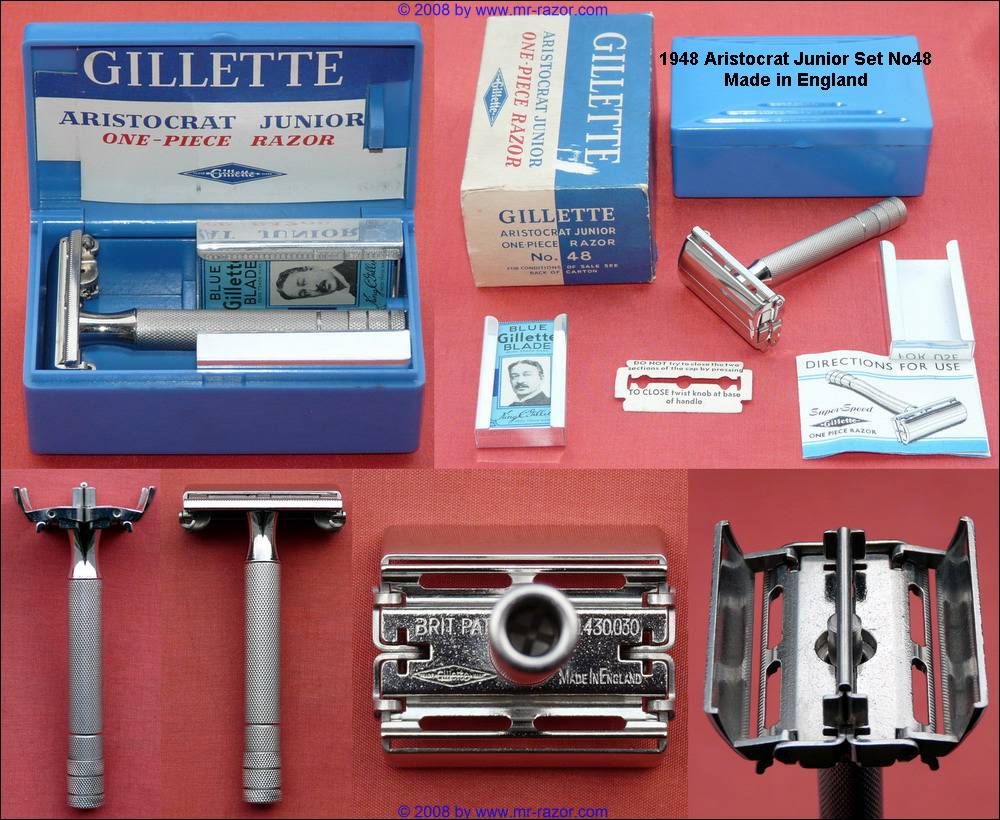
It was accompanied by the No. 49 (#49) set, which featured the same razor in a fancier case. In a modicum of hubris, the powers that be named it "the popular model." I do not know if they were grasping at nostalgia, recalling the "popular & standard" sets made in the previous decades, but, whatever the reason, we can be assured that Gillette sold it at a higher price point.
Below is a comparison of the #48, #49, and the #53 sets.

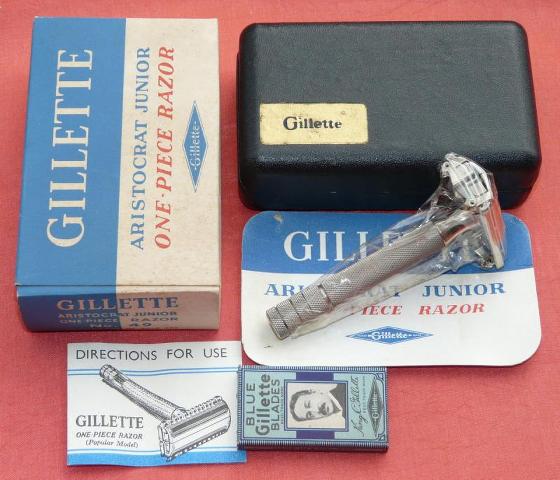
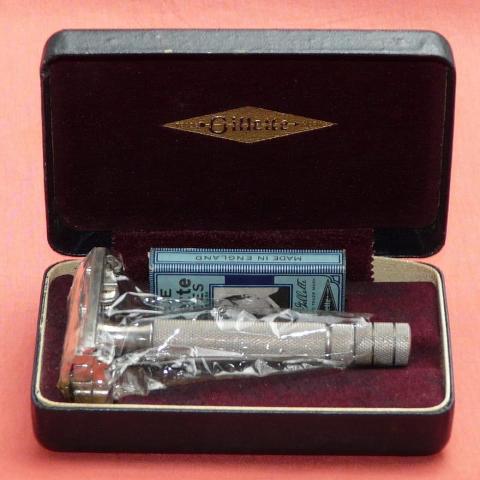

(@Useless shaver thank you for the information and photos of the #49 set.)
These were one of the few razors made in England that did not have a retracting Rocket style 'knob.' Instead, they used the American style '40's Super Speed handle, complete with the crimped band above the TTO mechanism. They also featured 'wings' on the ends of the blade alignment bar, and no end caps. They were made of brass, and nickel plated, and share the same head design as the #21 Aristocrat. They will always have Brit. Patent 430,030 stamped into the bottom of the baseplates, like many other British razors from that time period.
The fastest way to identify these razors is to ask two questions. Does it have a flat baseplate? Does it have a crimped band above the TTO knob? If the answer to both of those is yes, then it is a 1948-1949 Aristocrat Junior.
The next model of Aristocrat Junior was made from 1949-1952 (possibly as late as 1953). It was called the No. 51 (#51) or No. 53 (#53), depending on the case the razor came packaged in. The #51 sold for 7 shillings, 6 pence, and the #53 sold for 12 shillings.
No. 51 Aristocrat Junior.
%20Aristocrat%20jr.JPG)
No. 53 Aristocrat Junior
%20Aristocrat%20jr.JPG)
Both of these share the same Brit. Pat. 430,030 stamping of their predecessor, but there the similarity to it ends.
While the handle looks almost identical to a Rocket handle, there are a few differences. The TTO knob on the Rocket razor is flat, while the knob on these Aristocrat Juniors is a bit rounded on the bottom, also solid, unlike the hollow knob of the #48. The TTO mechanism is also just a bit tighter and smoother than the Rocket. Some people have said that the handle feels "heavier" than the standard Rocket handle, though that would be difficult to prove without destroying two razors. The 10 gram difference in weight can likely be attributed to the difference in head design.
While the head shares the same patent number as the 48-49 Aristocrat Junior, it is different. This model shares the same flat bottomed head type as the #16 Aristocrat, and is a little less aggressive than the previous Aristocrat Junior.
The CanadianAristocrat Junior Rocket.
It's a Rocket...kind of.
During the same 1948-1953 time frame, some of these British "Aristocrat Juniors" were being shipped to Canada, where they were packaged in Canadian made Rocket cases, with Canadian made blade dispensers and blades, and a Rocket instruction manual.
For a long time, the assumption was that these razors were in the wrong cases. After seeing about 20-30 of these razors in "the wrong cases" (particularly when the cases all happen to be Canadian) my willing suspension of disbelief begins to wane.


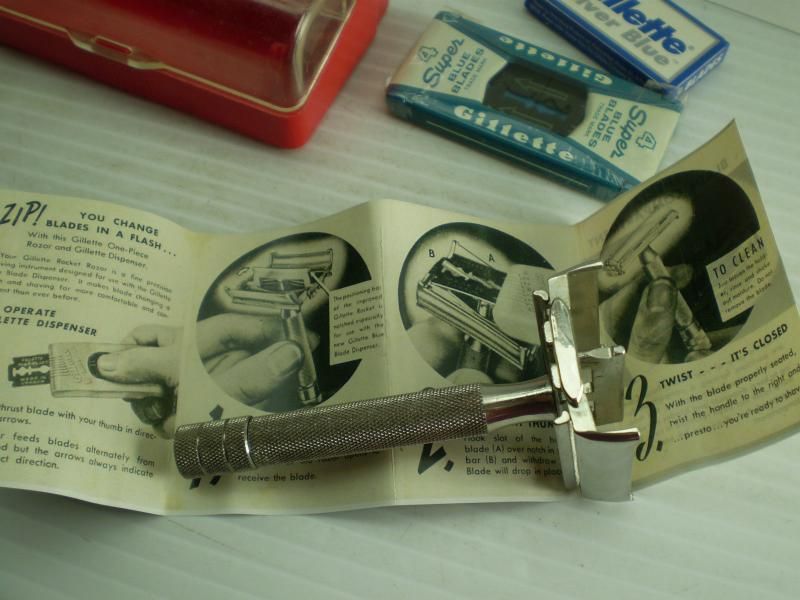
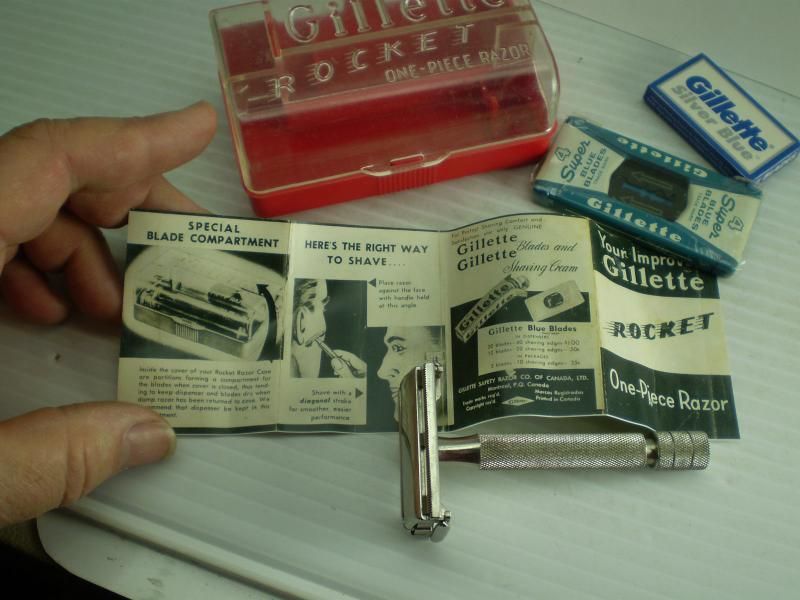
1953 saw the switch from the flat bottomed baseplate to the diamond stamped baseplates. Some people consider these razors to be nothing more than later model Rockets, and I'd have to agree.
...with one exception. We'll get to that in a minute.
The 1953-1954 Aristocrat Junior.
In late 1952 or early 1953, Gillette England switched from the flat baseplate design to the diamond baseplate design. Some of these models were aluminium and some were brass. They continued to be sold in the green #53 case.
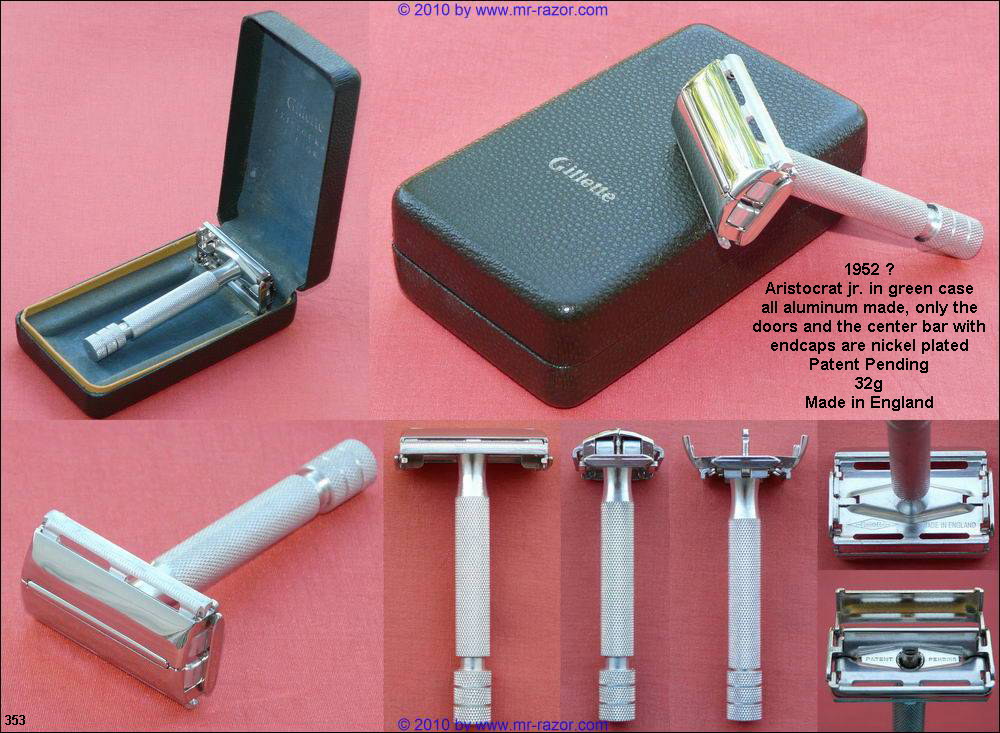
Because these British razors are so well polished and plated, they are often mistakenly thought of as being rhodium plated. They aren't, unfortunately. Just well plated nickel. Like the Rockets from this same time period, the blade trays are stamped Pat. Pending., and like the Rockets, the TTO knob has a flat bottom. The only way to distinguish this model of Aristocrat Junior from a Rocket is the case. These are less aggressive than the previous model of Aristocrat Junior. The weight on the aluminium models ranges from 27 grams to 34 grams.
Which brings us to that one exception...
1953 was the year of three Aristocrat Juniors. But only two, the previous models, were called an Aristocrat Junior. The other was called the No. 58 (#58) and was part of a three piece set of razors in specially marked cases to celebrate the coronation of Her Majesty, Queen Elizabeth II.
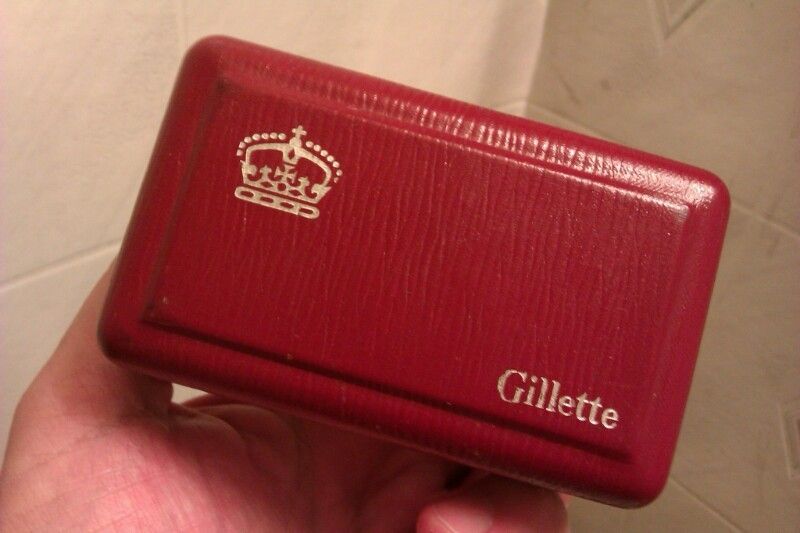
There are several variations of the #58. The first, made only in 1953, was the #58 Coronation Set. It came in a specially designed red leathette case with a gold crown on the lid. Most, if not all, of the 1953 #58's were made of aluminium. At least some of the 1954 sets were also aluminium. While the case remained the same from 1953-1958, only the 1953 set came with the crown marked case.
The set below is post 1953, but comes with blades manufactured in 1953.
%20No58%20aluminum.JPG)
The argument for including the No. 58 Set in the Aristocrat Junior line up rests on a single advertisement...
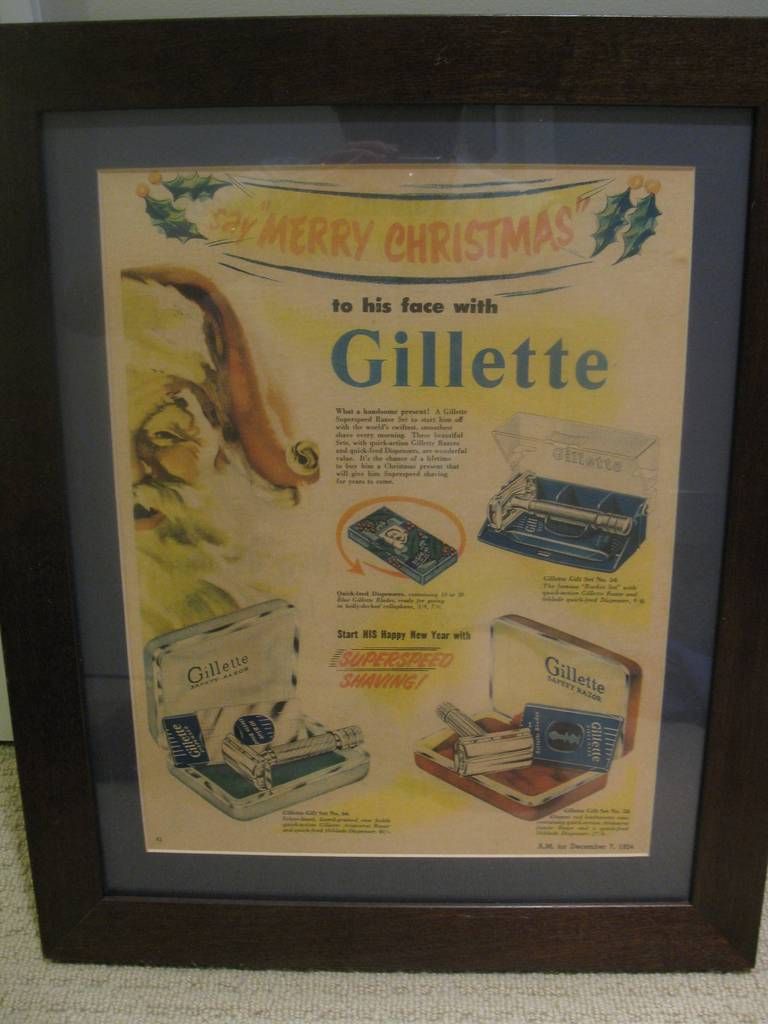
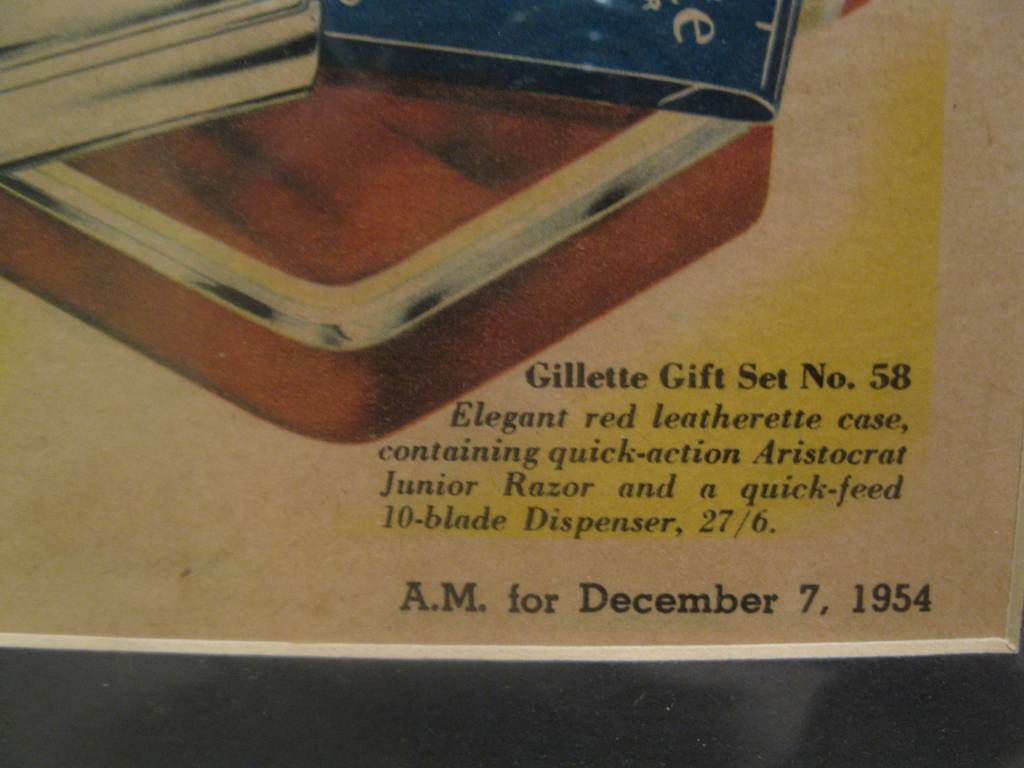
From the advertisement:
Gillette Gift Set No. 58
Elegant red leatherette case, containing quick-action Aristocrat Junior Razor and a quick-feed 10-blade dispenser, 27/6
27 Shillings, 6 Pence in pre decimal currency.
On the strength of that advertisement, we can say that the 1954-1958 No. 58 Sets should probably be considered Aristocrat Juniors. The 1953 set should remain, in my opinion, the "1953 No. 58 Coronation Set."
For the vast majority of wet shavers, the No. 58 is that strangest of creatures, a weird hybrid of an Aristocrat and a Rocket HD. If ever a razor deserved the moniker "Aristocrat Junior" the No. 58 Set surely does.
The brass model weighs in at a hefty 68-72 grams. The aluminium model weighs a mere 34 grams and is all aluminium except for the post, side plates and doors. They share the same head design as the #22/66 Aristocrat.
The 1953-1954 models can be identified by the Pat. Pending mark on the diamond stamped blade tray. All of the aluminium #58's and some of the brass models are marked Pat. Pending. 1954-55 models are marked with Brit. Pat. 694093 and some carry the II marking. In 1956, the red retaining band was added to the case and remained until the #58 set was discontinued in 1958, marking the end of the Aristocrat Junior Razor.
These razors (well, most of them, anyway) are much more than that. There are six models of Aristocrat Juniors. Two of those models also have aluminum varients, and one of the six models is identical to a late model Rocket. Another one is identical to an American Super Speed. For the most part, they are English Aristocrat heads on thinner handles, and for the most part, they are nickel plated brass or anodized aluminium. A few gold varients exist, but those are very uncommon. Most seem to be aluminium models.
The 'first' Aristocrat Junior was an American razor, the first and last of it's kind. It was, for all intents and purposes, a 1947 Super Speed razor in an Aristocrat Junior labeled box. I'm including it merely for the sake of completeness. It's the only American Aristocrat Junior, and unless one also owned the case, would be identified as a common Super Speed.
The first 'true' Aristocrat Junior was made in England from 1948-1949. It was called the No. 48 (#48).

It was accompanied by the No. 49 (#49) set, which featured the same razor in a fancier case. In a modicum of hubris, the powers that be named it "the popular model." I do not know if they were grasping at nostalgia, recalling the "popular & standard" sets made in the previous decades, but, whatever the reason, we can be assured that Gillette sold it at a higher price point.
Below is a comparison of the #48, #49, and the #53 sets.




(@Useless shaver thank you for the information and photos of the #49 set.)
These were one of the few razors made in England that did not have a retracting Rocket style 'knob.' Instead, they used the American style '40's Super Speed handle, complete with the crimped band above the TTO mechanism. They also featured 'wings' on the ends of the blade alignment bar, and no end caps. They were made of brass, and nickel plated, and share the same head design as the #21 Aristocrat. They will always have Brit. Patent 430,030 stamped into the bottom of the baseplates, like many other British razors from that time period.
The fastest way to identify these razors is to ask two questions. Does it have a flat baseplate? Does it have a crimped band above the TTO knob? If the answer to both of those is yes, then it is a 1948-1949 Aristocrat Junior.
The next model of Aristocrat Junior was made from 1949-1952 (possibly as late as 1953). It was called the No. 51 (#51) or No. 53 (#53), depending on the case the razor came packaged in. The #51 sold for 7 shillings, 6 pence, and the #53 sold for 12 shillings.
No. 51 Aristocrat Junior.
No. 53 Aristocrat Junior
Both of these share the same Brit. Pat. 430,030 stamping of their predecessor, but there the similarity to it ends.
While the handle looks almost identical to a Rocket handle, there are a few differences. The TTO knob on the Rocket razor is flat, while the knob on these Aristocrat Juniors is a bit rounded on the bottom, also solid, unlike the hollow knob of the #48. The TTO mechanism is also just a bit tighter and smoother than the Rocket. Some people have said that the handle feels "heavier" than the standard Rocket handle, though that would be difficult to prove without destroying two razors. The 10 gram difference in weight can likely be attributed to the difference in head design.
While the head shares the same patent number as the 48-49 Aristocrat Junior, it is different. This model shares the same flat bottomed head type as the #16 Aristocrat, and is a little less aggressive than the previous Aristocrat Junior.
The Canadian
It's a Rocket...kind of.
During the same 1948-1953 time frame, some of these British "Aristocrat Juniors" were being shipped to Canada, where they were packaged in Canadian made Rocket cases, with Canadian made blade dispensers and blades, and a Rocket instruction manual.
For a long time, the assumption was that these razors were in the wrong cases. After seeing about 20-30 of these razors in "the wrong cases" (particularly when the cases all happen to be Canadian) my willing suspension of disbelief begins to wane.




1953 saw the switch from the flat bottomed baseplate to the diamond stamped baseplates. Some people consider these razors to be nothing more than later model Rockets, and I'd have to agree.
...with one exception. We'll get to that in a minute.
The 1953-1954 Aristocrat Junior.
In late 1952 or early 1953, Gillette England switched from the flat baseplate design to the diamond baseplate design. Some of these models were aluminium and some were brass. They continued to be sold in the green #53 case.
Because these British razors are so well polished and plated, they are often mistakenly thought of as being rhodium plated. They aren't, unfortunately. Just well plated nickel. Like the Rockets from this same time period, the blade trays are stamped Pat. Pending., and like the Rockets, the TTO knob has a flat bottom. The only way to distinguish this model of Aristocrat Junior from a Rocket is the case. These are less aggressive than the previous model of Aristocrat Junior. The weight on the aluminium models ranges from 27 grams to 34 grams.
Which brings us to that one exception...
1953 was the year of three Aristocrat Juniors. But only two, the previous models, were called an Aristocrat Junior. The other was called the No. 58 (#58) and was part of a three piece set of razors in specially marked cases to celebrate the coronation of Her Majesty, Queen Elizabeth II.

There are several variations of the #58. The first, made only in 1953, was the #58 Coronation Set. It came in a specially designed red leathette case with a gold crown on the lid. Most, if not all, of the 1953 #58's were made of aluminium. At least some of the 1954 sets were also aluminium. While the case remained the same from 1953-1958, only the 1953 set came with the crown marked case.
The set below is post 1953, but comes with blades manufactured in 1953.
The argument for including the No. 58 Set in the Aristocrat Junior line up rests on a single advertisement...


From the advertisement:
Gillette Gift Set No. 58
Elegant red leatherette case, containing quick-action Aristocrat Junior Razor and a quick-feed 10-blade dispenser, 27/6
27 Shillings, 6 Pence in pre decimal currency.
On the strength of that advertisement, we can say that the 1954-1958 No. 58 Sets should probably be considered Aristocrat Juniors. The 1953 set should remain, in my opinion, the "1953 No. 58 Coronation Set."
For the vast majority of wet shavers, the No. 58 is that strangest of creatures, a weird hybrid of an Aristocrat and a Rocket HD. If ever a razor deserved the moniker "Aristocrat Junior" the No. 58 Set surely does.
The brass model weighs in at a hefty 68-72 grams. The aluminium model weighs a mere 34 grams and is all aluminium except for the post, side plates and doors. They share the same head design as the #22/66 Aristocrat.
The 1953-1954 models can be identified by the Pat. Pending mark on the diamond stamped blade tray. All of the aluminium #58's and some of the brass models are marked Pat. Pending. 1954-55 models are marked with Brit. Pat. 694093 and some carry the II marking. In 1956, the red retaining band was added to the case and remained until the #58 set was discontinued in 1958, marking the end of the Aristocrat Junior Razor.
Last edited:
